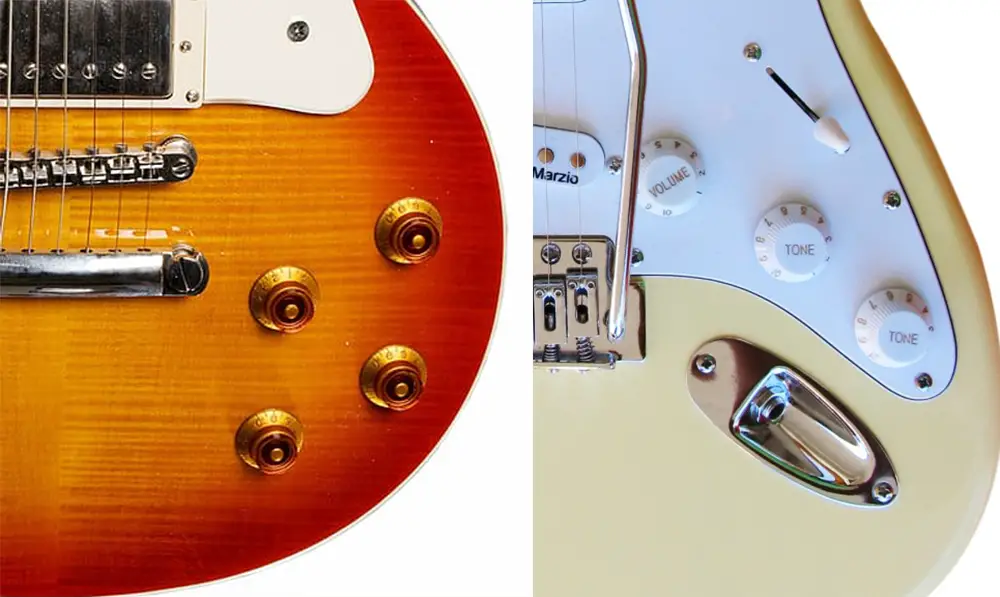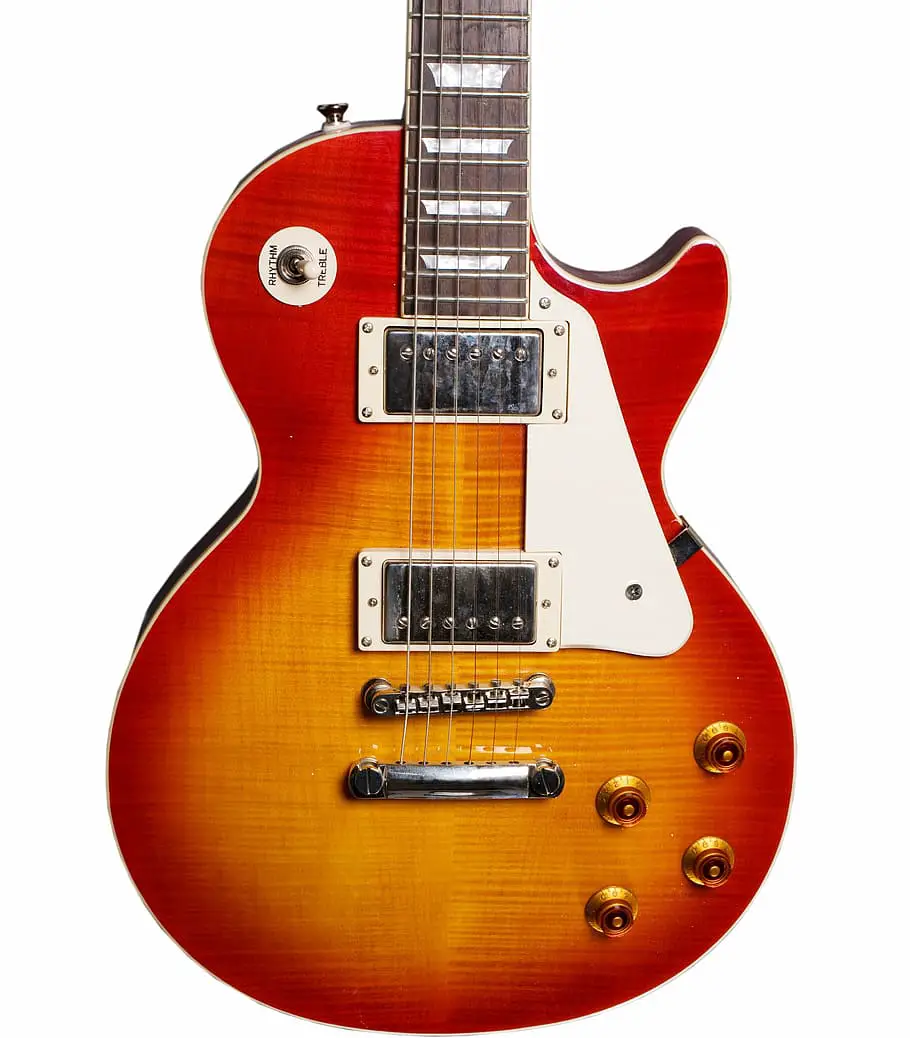As a guitarist, I’m not proud to admit that it took me quite a few years to figure out how to use my guitar knobs. The circuitry on a Guitar may be used for many purposes, and understanding what they are is critical to developing your sound.
There are generally two functions for the knobs on an electric guitar: a “volume” knob for controlling the volume output and a “tone” knob for tweaking treble frequency output. Turning the tone knob fully clockwise results in a brighter tone. Rotating the knob counterclockwise filters off the high frequencies, making the sound more subdued and mellow.
Since it truly altered the way I play, I decided to compile this in-depth and comprehensive article so that every guitar player is aware of what the knobs on a guitar do.
In this post, I’ll go through these settings in greater depth and address frequent concerns that you may have to make sure you can get the sound that you want.

Guitar Tone Knobs Explained
It might take time to discover a fantastic guitar tone because there are so many variables. As you play along, your tone preferences will emerge, and the tone you enjoy may vary from song to song.
What does a tone knob do on a guitar?
The tone control knob is used to alter the sound of your guitar. Tone knobs on electric guitars are potentiometers that reduce the high frequencies as you turn the knob down and increase them as you turn the knob up.
As you lower the number on your tone knob, also known as rolling back the tone, higher frequencies are increasingly removed from your guitar sound, resulting in a muddy tone.
The tone control allows you to adjust the clarity or brightness of your guitar tone by filtering high notes out or in. It’s all about the tone. The tone knob allows you to create different qualities of sound by changing how much treble and bass are mixed together.
Do you wish to create a smooth jazz tone or a brilliant rock lead? Start by adjusting your tone by using the tone knobs on your guitar. To discover what you want, play with it and experiment. It’s really a process that will never end, and you’ll always be experimenting with new tones and sounds.
I also adjust the tone knob a lot since I need a variety of timbre options during different songs. Sometimes I want a bright, twangy tone. Sometimes I want to roll back the treble for a more fat sound. It all depends on the situation.
How do you use a tone knob?
The tone knob can be mysterious. I know it took me a long time to even find a musical application for using the tone knob. How do you use the tone knob on a guitar?
The tone knob can be used to filter out higher frequencies. To have a straight, unaffected sound, turn the tone knob all the way up to 10. Turning the tone knob towards 0 removes more and more of the higher frequencies as you turn the knob.
Speaking from an electronics standpoint, the tone knob is a potentiometer and is part of a low pass filter. Turning the knob changes the resistance, which lowers the cut-off frequency.
This is similar to how a wah-wah pedal works, but wah-wah pedals may accentuate certain frequencies.
Guitar Knob Layouts
Depending on your guitar brand and how it’s laid out, you may find that your guitar either has:
- One volume knob and one tone knob (Ibanez Style)
- One volume knob and two tone knobs (Fender Strat Style)
- Two volume knobs and two tone knobs (Les Paul Style)
For the Fender type design, each tone knob controls the tone for one of the pickups. (isolated controllers). The volume knob affects the entire output at once. (master controller). The Les Paul design has two volume and two tone controls, which makes it more flexible.


Guitar Volume Knobs Explained
There are now hundreds of thousands of wacky effects pedals on the market. Effects pedals are a fantastic approach to bring forth some strange sounding beasts, every electric guitar includes one of the most flexible effects: the volume knob.
What does the volume knob on a guitar do?
Volume knobs on a guitar are potentiometers that increase or decrease the output level of the pickups when you turn the knob. The knob changes the value of the resistor from some resistance to maximum resistance. 250k or 500k Ohm pots are normally used.
A higher potentiometer value reduces the amount of treble that seeps into the ground via the potentiometer. This is easiest to see in Stratocasters which have naturally more treble single-coil pickups using 250k pots which will bleed more treble to ground than 500k pots that are used in a Les Pauls with humbucker pickups. The humbucking pickups have a darker timbre and therefore we want to keep as much of the high end as possible, which is why they use a higher pot value.
Audio Taper vs Linear Taper Pots
Pots are available in two basic forms: Linear taper and Audio taper. If you’re viewing the pot from the rear, audio tapers are typically marked with an “A” and Linear Tapers are marked with a “B.”
Fender uses audio taper pots for both volume and tone controls in their guitars. For both audio and tone controls, Gibson employs linear taper pots. Some manufacturers use a mix of audio taper and linear taper in their designs. So what’s the difference? Why would different companies use different types of pots?
The type of pots, like many things in the guitar and music world, is a matter of personal taste.
Linear taper, as the name implies, varies resistance from 0 Ohms up to the value of the pot (250k or 500k) with an even distribution. The relationship between the pot and the resistance is fixed, which means that if you set the control at 50% (Turn the knob to 5), it will have a resistance of 250k.
There is, however, a catch. The human ear does not perceive volume in a linear manner. The taper of the audio taper pot is intended to match our ears’ perception of volume change more precisely.
Typically, a linear pot will have a more noticeable cutoff right around 7 out of 10. An audio taper pot follows more of a logarithmic scale. Even though the resistance isn’t changing linearly, our ear hears it that way.
What is the pickup selector on the guitar for? How do I use the pick selector switch?
We went over how potentiometers function. We’ll now look at how pickup selector switches operate.
Most guitars have two or more pickups and each has a distinct sound depending on where it is placed and how it’s manufactured.
The pickup selector switch allows the guitarist to choose between the available pickups or a combination of them. The pickups are usually combined in parallel, but some guitars can put the pickups in serial.
Not all guitars have the same number of pickups, so the selector switch may vary on which pickups are selected.

